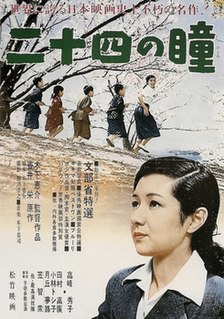 W
WThe Ballad of Narayama is a 1958 Japanese period film directed by Keisuke Kinoshita and based on the 1956 novella of the same name by Shichirō Fukazawa. The film explores the legendary practice of obasute, in which elderly people were carried to a mountain and abandoned to die.
 W
WBig Joys, Small Sorrows is a 1986 Japanese film directed by Keisuke Kinoshita, revisiting his melancholic earlier work, Times of Joy and Sorrow (1957), of a lighthouse keeper and the transient lifestyle he and his family endure. Shot at 10 different lighthouses, four temples, and various scenic locations, spanning the length of Japan from Kyushu to Hokkaido, the film serves a secondary purpose as an insightful time capsule travelogue of early 1980s Japan.
 W
WCarmen Comes Home is a 1951 Japanese comedy film directed by Keisuke Kinoshita. It was Japan's first feature length colour film.
 W
WThe Garden of Women is a 1954 Japanese drama film directed by Keisuke Kinoshita. It is based on the novel Jinkō Teien by Tomoji Abe.
 W
WImmortal Love a.k.a. Bitter Spirit is a 1961 Japanese drama film written and directed by Keisuke Kinoshita. It was nominated for the Academy Award for Best Foreign Language Film. Masakazu Tamura made his official debut in the film.
 W
WA Japanese Tragedy , also known as Tragedy of Japan, is a 1953 Japanese drama film written and directed by Keisuke Kinoshita. The film tells the story of a mother who has to raise two children during and after World War II, but whose children reject her. Kinoshita interspersed newsreel footage within the film in an attempt to relate the story of the film to the wider context of Japan's post-war difficulties.
 W
WThus Another Day is a 1959 color Japanese film directed by Keisuke Kinoshita.
 W
WTimes of Joy and Sorrow, The Lighthouse, or 喜びも悲しみも幾歳月 , is a 1957 color Japanese film directed by Keisuke Kinoshita, who shot on location at 10 different lighthouses throughout Japan, including opening scenes at Kannonzaki, the site of the country's first lighthouse.
 W
WTwenty-Four Eyes is a 1954 Japanese drama film directed by Keisuke Kinoshita, based on the 1952 novel of the same name by Sakae Tsuboi. The film stars Hideko Takamine as a schoolteacher named Hisako Ōishi, who lives during the rise and fall of Japanese nationalism in the early Shōwa period. The narrative begins in 1928 with the teacher's first class of first grade students and follows her through 1946.